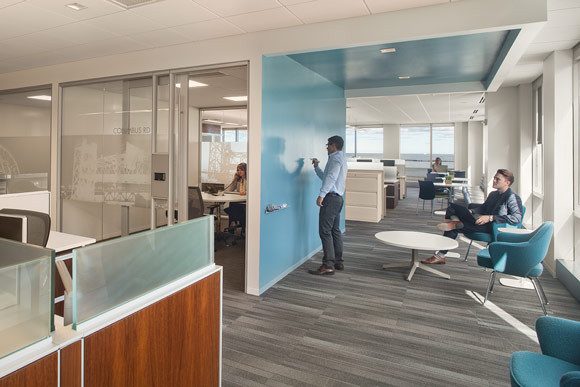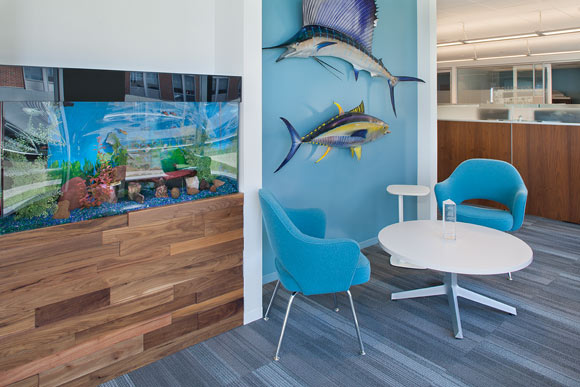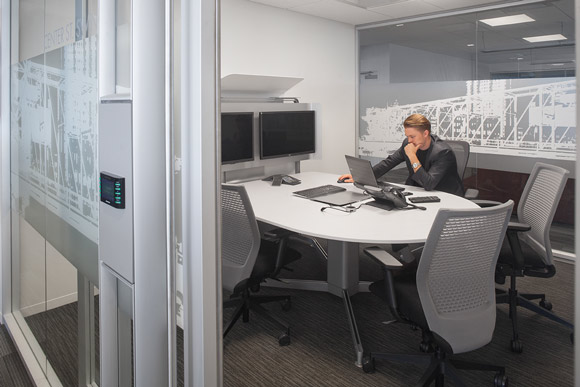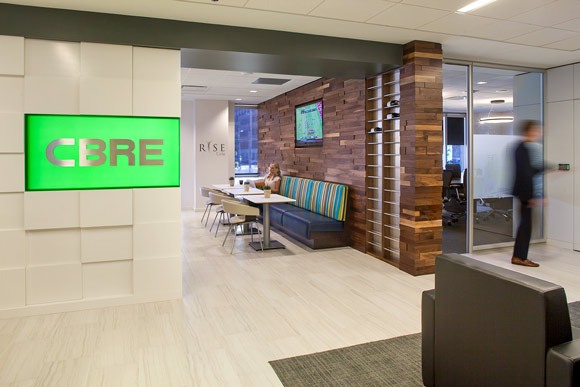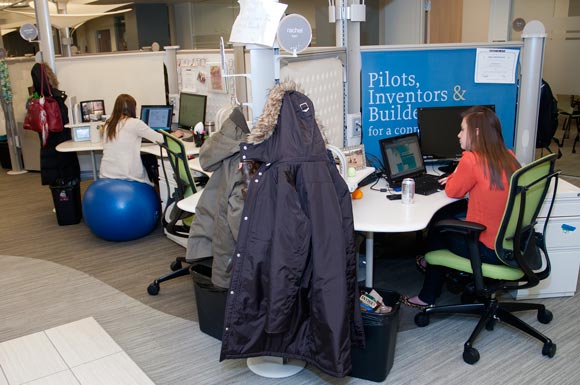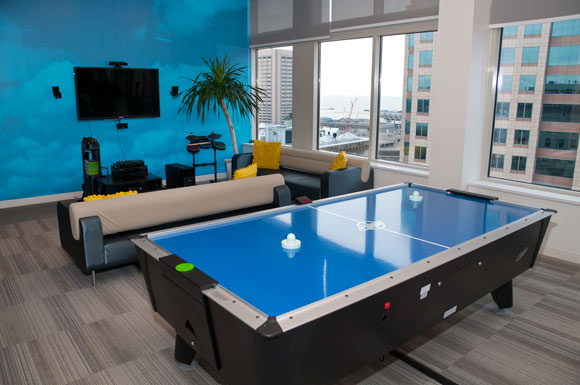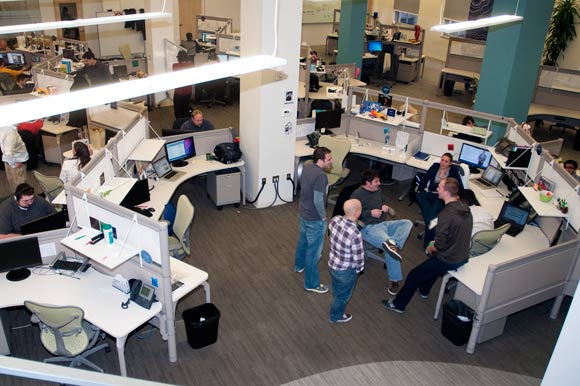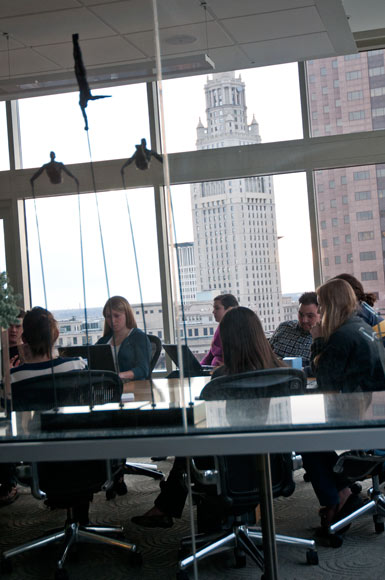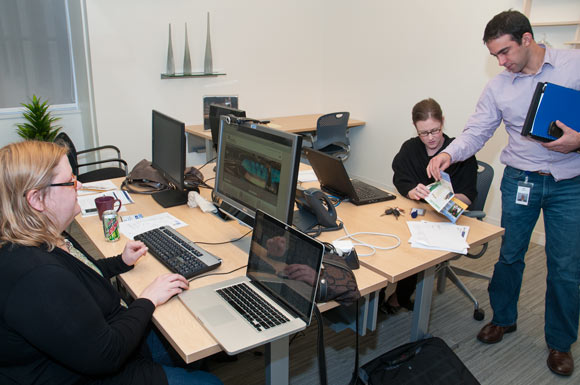forget the corner office: cleveland's hottest workspaces are open, collaborative, connected
David Browning is the Market Leader for the Cleveland/Akron office of C.B. Richard Ellis, one of the largest commercial real estate brokerages in the world, yet he doesn’t have an office.
Instead, he sits in a six-by-eight foot cubicle identical to that of his colleague's workspaces. But this is no typical cube farm; the sleek, contemporary desks have laptop docking stations, rolling file cabinets, ample workspace, twin computer monitors and almost no walls.
CBRE’s workspaces also boast to-die-for views. On a recent January day, CBRE’s new offices on the second floor of the Ernst and Young Tower in the Flats provided workers with a brilliant white vista of Lake Erie, the river and the port.
If and when Browning does need some privacy, he’s got 14 different conference rooms from which to choose (the old offices had just four). Also, the whole place is wired like Q Branch in a Bond movie, from the “follow me” printing that spits out only after an ID is scanned (keeping confidential info out of the printer tray), to the hardwired phones that go mobile with the touch of a button.
Yet while the gadgets are cool, the biggest boon is the close collaboration nurtured by open space. There are dozens of cool nooks around the office where people can bump into one another. Browning wanted to promote the kind of “serendipitous interaction” that leads to higher levels of knowledge transfer and productivity, he says.
“You used to come into the office because this is where you worked," says Browning. "You had access to phones and were plugging into hardwired technology. Now everyone has one of these [smart phones]. The office is really a place where you connect into resources and support staff and collaborate with fellow professionals and clients.”
Deb Donley of Vocon, the architectural firm that designed the space, agrees. “More and more we’re finding that the overall environment and culture you create are more important than the door you may or may not be given,” she says. “The real value happens when a junior person is sitting next to a senior person. Knowledge transfer happens at such a higher rate when you’re all sitting together as opposed to behind a door.”
The urbanization of office space
Technology has driven changes in office space for years. Over the past decade, average space allocation has dropped from 225 square feet per person to 150. Yet that downward shift has accelerated in the post-recession economy as corporations seek to shed costs and become more efficient and productive by embracing a mobile, collaborative workplace culture.
Breaking down walls is just the tip of the iceberg. Other office design trends include more shared space, more amenities and more tolerance (even encouragement) of telecommuting and working from "third places." You might lose your office – and even your desk – but you might gain better coffee, a sweet lounge and, perhaps, an air hockey table.
According to CoreNet, an association for commercial real estate professionals, space allocation will drop to less than 100 square feet per worker at many companies by 2017. This could result in a glut of excess office space nationwide, but the densification trend might benefit cities, which are rich in the density and the amenities that firms are seeking.
“People are moving back to urban centers,” says Donley. “The younger generation is more inclined to live, work and play downtown.”
If the millennial generation is embracing urban density, so too are many companies when it comes to their offices. If the stodgy offices of the past can be likened to picket-fence Cape Cods with attached garages, today’s are more like modern apartment buildings with micro living spaces but kick-ass roof decks.
That’s a trend that encourages Michael Deemer, Director of Business Development for Downtown Cleveland Alliance, whose job it is to recruit companies to the urban core.
“The office market is benefitting from the trend of younger, tech-oriented companies moving into or expanding to take advantage of the millennial generation's preference for working and living downtown,” he says. “At the same time, we see more traditional professional industries like law and financial services also relocating and expanding downtown to take advantage of very competitive lease rates and unique office space.”
Companies choosing downtown
While downtown’s vacancy rate hovers close to 20 percent (and actually ticked up slightly this year), Deemer says the overall trend is positive. Despite Eaton’s departure in early 2013 – a move that left a 300,000-square-foot hole in the market – downtown Cleveland had net positive absorption for the year, no small feat.
Companies like Rosetta, Onosys and Britton Gallagher are choosing downtown for the ability to customize their office space, attract and retain talent and create a collaborative culture.
The digital marketing agency Rosetta occupies 80,000 square feet on six floors of the National City Bank Building at E. 6th and Euclid. The space features kitchens on every floor (a lemon-filled vase subtly reminds visitors of the company’s brand), funky cubes that are anything but square, huge windows with killer views, state-of-the-art conference rooms, and a lounge with ping pong table on the penthouse level.
Perhaps most telling is the fact that the firm’s top executives surrendered penthouse-level offices to create an ideal space for watching fireworks, throwing parties or popping champagne to toast big deals. Instead, the top brass work alongside the "little people."
About 20 percent of Rosetta employees walk to work, and the culture is young, social and creative. After-work drinks and volleyball tournaments at Whiskey Island are common.
“Of all the jobs I’ve ever had, I am most myself at Rosetta,” says Julie Fratus, Senior Recruiter for the company. “This is not a heads-down environment. People do work hard, but we take time all day to build relationships and have fun.”
It’s the little touches that count. The receptionist keeps a cup for ping pong balls that bounce down the stairs. Fratus and other associates like to head up to the penthouse to watch thunderstorms roll through as it’s a great place for sky watching.
Onosys, which makes online ordering software for the restaurant industry, embraced a similar culture when it chose offices on W. 6th Street. Co-founder Stan Garber says he and his partners kept asking the same question as they looked at traditional office spaces across downtown: “What’s it going to take to break down those walls?”
Today, Onosys has a completely open office, which can be challenging. “The whole idea was to keep everything transparent, to know what everybody is working on,” Garber says. “That forces you to do the right thing more often – to be a better manager. You really are exposed, and everything you say will be heard. It also breeds collaboration.”
Commercial insurance broker Britton Gallagher departed Solon for downtown 18 months ago, won over by a big push from the city. The next challenge was to convince employees, so the firm organized a bus caravan so employees could listen to presentations from the city, police chief and others to convince them it was “safe.”
Today, most people love it, says Sean Kelley, Senior Vice President of Benefits. The firm’s views from One Cleveland Center are amazing, the new open office environment nurtures collaboration, and the company is able to attract a new class of workers thanks solely to its address.
Winners and losers
The factor driving most companies towards more compact office space is, of course, cost. Next to personnel, real estate is likely to be a corporation’s largest expense, says Donley. But if done right, it can be a win-win. CBRE reduced its total space from 19,000 to 15,000 square feet, and even though it’s paying higher rents, it reduced its costs. That kind of space efficiency is one reason why the E&Y Tower is now more than 90 percent full.
Densification, however, is not for everyone. Nor is there a one-size-fits-all model.
“Densification without thought or strategy could be a disaster,” says Donley, who stresses that Vocon completed extensive surveys of CBRE’s workplace habits and culture before designing the new space. “It’s really important for us to align real estate and space strategy with where the company is headed as a business.”
Donley says companies that don’t embrace a more open, collaborative workplace environment may be left behind, an argument underscored by the fact that renovated Class A downtown office space has a much lower vacancy rate than Class B office space without similar updates. “If you don’t have an environment that supports a multigenerational workforce, you will find yourself in trouble,” Donley argues.
Some of that Class B space is now being transformed into apartments, however, a trend that will further fuel the live-work-play environment downtown.
Browning says that although there will be “winners and losers” in the downtown market, the overall environment still is trending upwards. “If you’ve got an older building with lots of walls and private offices, it may be a challenge to lease going forward without spending a lot of money to rehabilitate it,” he admits.
Of course, the “spending a lot of money” part can be difficult to justify in an office market with nearly 20 percent vacancy rates and lease rates that are not rapidly rising.
Yet Browning maintains that downtown Cleveland’s office market is on the rise, driven largely by younger people who enjoy the city’s excitement.
“We are seeing more of people, not less,” he says. “People want to be downtown. They like the energy and vibe.”
Photos Bob Perkoski
CBRE photos - Maguire Photo of Akron













